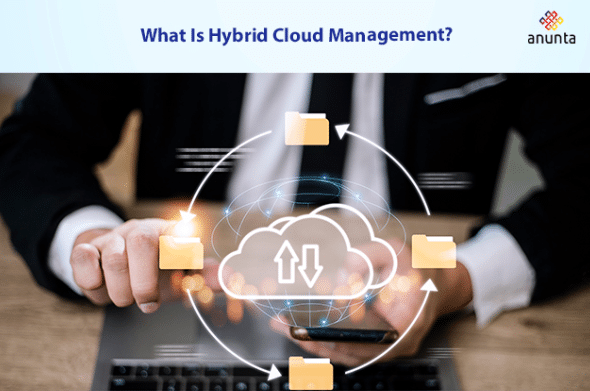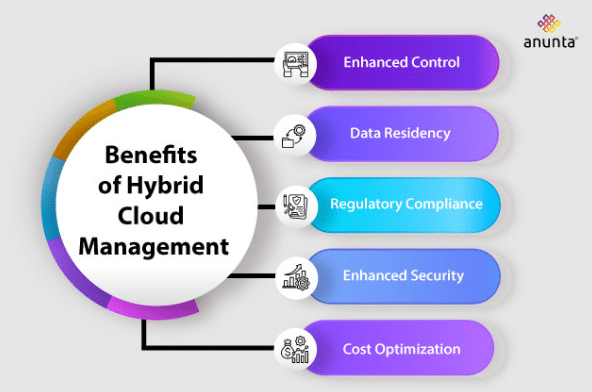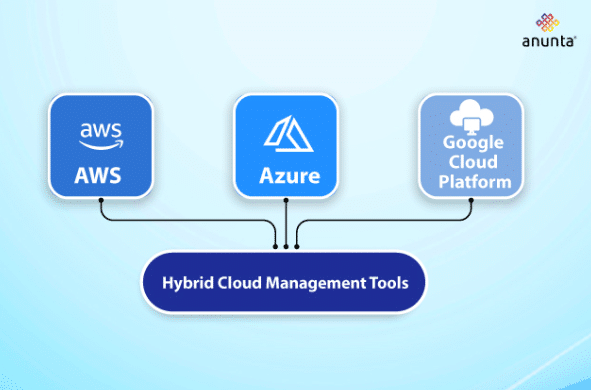
Imagine having the flexibility to run your business operations across both public and private clouds, seamlessly managing workloads without the usual headaches. That’s the promise of Hybrid Cloud Management.
But how does it work, and why is it a game-changer for companies striving to stay ahead? In this blog, we’ll break down the concept, reveal its advantages, and show you how it could transform how you manage your IT resources. Let’s explore!
Hybrid cloud management integrates the oversight of hardware resources across multiple public clouds with private cloud infrastructure within an on-premises data center. For many organizations, data security policies restrict the remote hosting of specific information or software on third-party hardware.
While the public cloud model challenges traditional private data centers, hybrid cloud solutions maintain the benefits of legacy systems while expanding capacity with public cloud resources. Today’s hybrid cloud networks often support essential SaaS and PaaS applications, enhancing daily workflows and productivity.
Hybrid clouds blend resources and services from various computing environments, necessitating smooth integration, orchestration, and coordination for efficient data sharing, movement, and synchronization. To ensure seamless deployment, effective hybrid cloud networking relies on local area networks (LANs), wide area networks (WANs), virtual private networks (VPNs), and application programming interfaces (APIs).
In hybrid cloud architectures, resources are abstracted and aggregated using virtualization, containerization, and software-defined networking and storage technologies. Dedicated management software oversees resource allocation and on-demand provisioning across different environments, much like other cloud computing models.
A hybrid cloud offers companies the flexibility to select the best aspects of public cloud and on-premises solutions, allowing them to make trade-offs based on their specific needs.
With an expanding array of hybrid deployment models, businesses can fine-tune their combination of cloud and on-premises services to match their requirements better. Here are some key advantages of adopting a hybrid cloud:

Enhanced Control: Many companies prefer not to fully relinquish control over specific data or computing tasks to third-party providers. Concerns often revolve around the physical management of storage and backups, decisions regarding infrastructure setup, and application control.
The variety of hybrid cloud models available today enables organizations to tailor their data and resource management to maintain the level of control they desire while still enjoying cloud benefits.
Data Residency: Hybrid cloud solutions are advantageous for meeting data residency requirements. They allow organizations to store data on-site or within specific national boundaries while leveraging the advantages of public cloud services.
Regulatory Compliance: Besides data residency, public cloud environments can assist companies in achieving various compliance standards. These include the Payment Card Industry Data Security Standard (PCI DSS) for credit card processing, the Health Insurance Portability and Accountability Act (HIPAA) for patient privacy, the General Data Protection Regulation (GDPR), and federal security standards like the US’s FedRAMP.
Enhanced Security: Public cloud providers often have greater resources and specialized expertise dedicated to security, surpassing what most individual companies can afford.
Although an organization’s IT team retains responsibility for data security in the cloud, partnering with a large-scale provider improves the likelihood of protection against the latest threats. A hybrid setup allows companies to benefit from advanced cloud security measures while keeping some computing needs on-premises for control or latency.
Cost Optimization: A hybrid cloud model offers ongoing opportunities to compare the costs of running applications in-house versus in the cloud. Organizations can use a hybrid approach to convert some capital expenses into more manageable operational costs while only paying for their cloud resources.
Businesses must develop a comprehensive hybrid cloud management strategy before diving into the technology aspects of creating a unified hybrid cloud management platform. While each strategy will vary depending on specific business goals, there are several key steps to start with:
Establish clear policies and outline roles and responsibilities for team members within the hybrid cloud ecosystem.
Determine the appropriate location for each workload, whether it should be hosted in a private or public cloud.
For example, a financial services company might use a private cloud to store sensitive customer data and a public cloud to test new customer service mobile apps. Evaluate which workloads could benefit from cloud-native, microservices-based technologies to enhance performance.
It’s essential to carefully review the terms of cloud service level agreements (SLAs), with particular attention to system uptime, latency, and data availability conditions. In a complex hybrid multi-cloud environment, misaligned SLAs can impact pricing, service quality, and the overall customer experience, making it crucial to thoroughly understand all terms.
Adopt a comprehensive zero-trust security strategy to ensure end-to-end consistency. Since data security ultimately rests with the data owner, organizations must apply uniform security, compliance, and regulatory practices across all environments: on-premises, private cloud, and public cloud.
Also Read: Cloud Migration Strategy
Previously, IaaS vendors were hesitant to integrate their cloud platforms with customers’ on-premises infrastructures. Today, however, many companies are embracing this approach. As a result, several leading platforms now offer robust hybrid cloud computing services.

Amazon’s AWS is a leading provider of cloud computing services, offering on-demand solutions and APIs for organizations and individuals. AWS’s hybrid cloud capabilities enable businesses to extend their infrastructure seamlessly between on-premises and edge environments. With services like AWS Outposts, AWS Wavelength, and AWS EKS Anywhere, AWS simplifies multi-cloud management and containerization.
Microsoft’s Azure stands out as another major cloud service player. This platform provides comprehensive access and control over software, hardware, applications, and services through a network of global data centers. Azure facilitates application development and features Azure Stack as its core hybrid cloud solution.
With its Google Cloud Platform, Google is rapidly advancing in the cloud space, leveraging the same robust infrastructure that supports its popular services like Gmail, YouTube, and Google Drive. Google Cloud offers Anthos, a container-based hybrid cloud management tool that enables users to manage and deploy Kubernetes workloads across various environments.
At Anunta, we’re redefining cloud management solutions with strategies designed to modernize your business. Our expert team offers tailored cloud management solutions to optimize your infrastructure, ensuring seamless integration and peak performance. From enhancing scalability to fortifying security, we provide end-to-end support that aligns with your unique business needs.
Transform your business today with Anunta’s reliable and efficient cloud management.
A: Hybrid Cloud Management integrates public cloud resources with private cloud infrastructure, allowing businesses to oversee both environments from a unified platform. It combines the benefits of both models for better control, scalability, and cost efficiency.
A: A Hybrid Cloud blends resources from public and private clouds, using technologies like virtualization and APIs for seamless integration. It ensures efficient data sharing and synchronization across different computing environments.
A: Benefits include enhanced control over data, improved data residency compliance, regulatory adherence, advanced security, and cost optimization.
A: Key steps include defining policies and responsibilities, allocating workloads appropriately, reviewing cloud SLAs, and implementing a zero-trust security approach.
A: Popular tools include AWS Outposts, Azure Stack, and Google Cloud’s Anthos. These platforms offer robust hybrid cloud capabilities, enabling seamless integration and management of cloud resources across various environments.
A: Anunta provides tailored cloud management solutions to optimize your hybrid cloud infrastructure. Their expertise ensures seamless integration, improved scalability, and enhanced security, aligning cloud resources with your business needs for peak performance and efficiency.